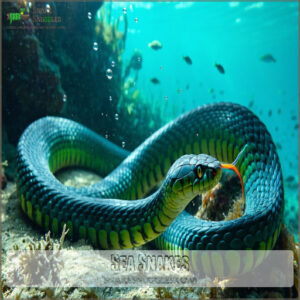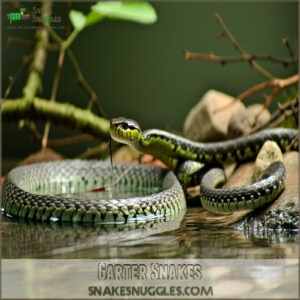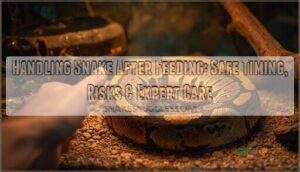This site is supported by our readers. We may earn a commission, at no cost to you, if you purchase through links.

These snakes fall into two categories: viviparous, where babies are born alive, and ovoviviparous, where eggs hatch inside mom just before birth.
Some examples? Garter snakes are a common one, often spotted in backyards. Boa constrictors are another—big, beautiful, and live-bearing.
Don’t forget sea snakes; they do this too, which fits their watery lifestyle. And then there are vipers, like rattlesnakes, that skip laying eggs altogether.
Nature’s always surprising us, right? Want even more fascinating facts? There’s so much to learn about these slithery wonders!
Table Of Contents
- Oviparous Vs. Viviparous Vs. Ovoviviparous
- Evolution of Live Birth in Snakes
- Snakes That Give Live Birth
- Unique Reproductive Strategies Across Species
- Conservation and Observation
- Frequently Asked Questions (FAQs)
- What snakes in the United States lay eggs?
- Do snakes lay eggs or give birth?
- Which snakes give birth to live offspring?
- How many types of snakes give live birth?
- Do sea snakes give birth?
- Do viviparous snakes give birth?
- Do lizards and snakes give live birth?
- What kind of snakes have live births?
- Do copperheads have live births?
- Do grass snakes give live birth?
- Conclusion
Oviparous Vs. Viviparous Vs. Ovoviviparous
Did you know snakes have three fascinating ways to bring their babies into the world? Let’s break down these reproduction modes simply.
Oviparous snakes (about 70% of species) lay eggs that develop outside mom’s body. Think of it as dropping off kids at daycare – mom lays her clutch and often leaves egg incubation to nature’s care. Snakes use various reproduction methods depending on their species and environment.
Viviparous snakes give actual live birth. These live-bearing snakes develop babies inside with a placenta-like connection, providing direct maternal care until birth when fully-formed snakelets emerge ready for action.
Live-bearing snakes nurture their young inside, ensuring baby snakelets are born fully-formed and ready to face the world independently.
Ovoviviparous snakes use a clever middle approach. They keep eggs inside their bodies until hatching time – like having an internal incubator! The babies develop in egg yolks within mom, then emerge from their shells just before or during birth.
Each birth method represents amazing adaptations in snake development that help these remarkable reptiles survive in different environments.
Evolution of Live Birth in Snakes
You’ll be amazed to learn that live birth in snakes evolved as a clever adaptation to protect babies from predators and harsh weather.
While most reptiles lay eggs, about 20-30% of snake species decided to keep their young inside a bit longer, giving their little ones a better chance at survival in tough environments.
This unique strategy is a testament to the remarkable diversity of snake species, with live birth being a notable exception to the common practice of laying eggs.
Reasons for Evolution
While most reptiles lay eggs, some snakes have evolved to give live birth for good reasons.
When faced with predators who’d happily munch on vulnerable eggs, viviparous snakes developed an ingenious solution: keep babies safe inside mom! This evolutionary trick helps species like water snakes thrive despite environmental pressures.
Climate adaptation plays a huge role too. In colder regions, internal development gives offspring a temperature-controlled environment. For ovoviviparous snakes like rattlesnakes, this genetic variation offers a substantial survival advantage over their egg-laying cousins.
Snakes exhibit unique live birth methods to safeguard the survival of their young.
Survival Benefits
Through the evolutionary marvel of live birth, snakes have discovered incredible survival advantages.
When you understand viviparous snakes, you’ll appreciate nature’s ingenious solution to environmental challenges.
Five amazing benefits of snake live birth:
- Predation avoidance for developing young
- Climate adaptation in harsh, cold environments
- Maternal care throughout development
- Higher offspring survival rates in aquatic habitats
- Immediate defensive capabilities at birth
This reproductive success story helps snakes thrive where egg-layers simply can’t! Snakes that exhibit live birth characteristics have unique adaptations that enable them to survive in various environments, showcasing their evolutionary marvel and reproductive success. They have amazing benefits and unique adaptations that make them survival advantages.
Snakes That Give Live Birth
You’ll be amazed to discover that about 20-30% of snake species worldwide don’t lay eggs but instead give birth to live young, just like mammals do.
These special snakes, including garter snakes, boas, and sea snakes, have evolved this clever birthing strategy to protect their babies from predators and harsh environments, giving their offspring a better chance at survival right from the start, which is a remarkable example of evolved strategy.
Rinkhals
The Rinkhals, a standout among live-bearing snakes, amazes with its ability to birth 20-35 venomous snakelets.
As ovoviviparous snakes, they carry eggs internally, making survival easier for young ones.
Found in grasslands and mountains, Rinkhals thrive in tricky environments, thanks to their cytotoxic venom and defensive tricks.
Rinkhals Facts Details
Habitat
Diet
Reproduction
Protecting Rinkhals guarantees their critical role in controlling ecosystems stays unbroken!
Sea Snakes
Sea snakes, the ocean’s slithering wonders, make waves in reproduction.
These viviparous snakes skip the eggs, giving live birth underwater.
Sea Snake Habitats thrive in tropical waters, where their diving abilities and venom adaptations help nab fish and eels.
With graceful moves and potent defenses, they’re masters of marine life.
But their Conservation Status isn’t so sunny—climate change and habitat loss leave these snake species in troubled waters.
The unique aspect of sea snake live birth processes involves sea snake reproduction that fascinates scientists and researchers.
Water Snakes
Swimming through rivers and wetlands, water snakes are masters of aquatic survival.
These live-bearing snakes, or viviparous snakes, skip egg-laying, ensuring offspring protection from predators and harsh environments.
Here’s what makes them fascinating:
- Water Adaptation: Their streamlined bodies excel in freshwater ecology, hunting fish and frogs with ease.
- Snake Habitats: Thriving in lakes and marshes, they’re essential to maintaining balance.
- Aquatic Survival: Predators beware—a nasty musk warns intruders!
Water snakes are freshwater defenders, showcasing nature’s brilliance.
Garter Snakes
Garter snakes are incredible ovoviviparous reptiles. Unlike viviparous snakes, garter snakes develop their young in eggs inside their body until hatching.
Amazingly, the baby snakes rely on yolk sacs for nourishment—not mom directly. You’ll find them in diverse habitats, from gardens to wetlands, showcasing unique garter behavior.
Their snake mating rituals and seasonal snake migration are intriguing too. These live-bearing snakes emphasize nature’s variety, blending survival strategies seamlessly into their garter snake habitat.
Garter snakes exhibit complex viviparous traits that set them apart from other species, highlighting their unique characteristics and survival strategies.
Boa Constrictors
Boa constrictors are some of the most fascinating live-bearing snakes you’ll ever hear about.
These viviparous snakes, from Central and South America, forgo laying eggs entirely—they give birth to live, wriggling snakelets!
It’s like nature’s version of skipping the waiting room.
These snakes grow up to a whopping 13 feet long and are known for their gorgeous patterns.
Let’s talk boa behavior and reproduction: Female boas carry their little ones for 5-8 months, producing litters of 10-64 babies.
These tiny boas arrive fully independent, wrapped in membranes they escape from at birth—instant survival mode!
Male boas even have vestigial pelvic spurs, little leftovers from prehistoric legs, used for gripping females.
- Boa Habitat: Rainforests, savannas, and grasslands.
- Reproductive Modes: Viviparity—live birth, no eggs!
- Constrictor Diet: Small mammals and birds; natural pest control.
Plus, they’re surprisingly important for ecological balance, keeping rodent populations in check.
Unique Reproductive Strategies Across Species
You’d be amazed at how animals have evolved all kinds of tricks to bring their young into the world.
From frogs that carry eggs in their mouths to seahorses where dads do the heavy lifting, nature’s creativity never disappoints!
Frogs
Frogs are full of surprises.
Unlike reptiles, their adaptations include laying jelly-like eggs in water or moist environments, often creating foam nests for protection.
Some frog species like Darwin’s frog take things further—males incubate tadpoles in their vocal sacs.
Frog habitats range from rainforests to deserts, where their life cycle thrives.
Whether it’s guarding eggs or unique diets, these survival tricks make frogs true champions of evolution and conservation, showcasing their remarkable ability to adapt, which is a key aspect of their survival tricks.
Seahorses
Here’s a wild twist: in seahorse mating, males are the ones who get "pregnant." A female deposits eggs into the male’s brood pouch, where he fertilizes and nurtures them.
These underwater dads handle it all, giving birth to dozens—sometimes hundreds—of tiny seahorses!
- Seahorse Courtship: Eight-hour mating dances.
- Seahorse Habitat: Found in seagrass, coral reefs, mangroves.
- Seahorse Diet: Tiny crustaceans and plankton.
- Parenting Champions: Male births, not females!
- Amazing Seahorse Behavior: Masters of camouflage.
Who knew parenting could flip like that?
Lizards
Lizards are like nature’s survival experts, showing off incredible reproductive methods.
From laying eggs to live births, they’ve perfected adapting to harsh environments like deserts and forests.
Some even rewrite biology books!
Take the whip-smart whiptail lizards – they skip males entirely and still have babies.
- Lizard Habitats shape their amazing birth strategies.
- Scaly Skin isn’t just cool; it’s essential for desert adaptation.
- Cold Blooded creatures like lizards prove life thrives everywhere.
Who knew reptile behavior was this fascinating?
Mammals
In the context of Mammal Evolution, these animals know how to shake things up.
From placental mammals to quirky marsupials, even egg-laying monotremes, their reproduction strategies are mind-blowing.
Whether cradling babies in a pouch or nourishing them inside, mammals keep survival top-tier.
Imagine if there were mammal-like snakes using similar tricks! Nature sure loves experimenting with viviparous species like live-bearing snakes!
The study of mammal reproduction involves understanding complex mammal reproductive processes.
Conservation and Observation
You can make a huge difference by protecting snakes that give live birth, many of which face habitat loss and other threats.
Watching a live-bearing snake in its natural environment is a rare treat, so grab your binoculars and some patience to observe these amazing creatures that give live birth.
Protecting Live-Bearing Snakes
Protecting live-bearing snakes isn’t just about letting them slither on—it’s about serious action.
Many snakes utilize various defense mechanisms for survival. Habitat preservation tops the list to help species like viviparous snakes thrive in their natural environments.
Want to lend a hand? Here’s how:
- Conserve Wetlands: These are home to aquatic live-bearing snakes, like water snakes.
- Support Snake Sanctuaries: Sanctuaries protect both snakes and their environmental adaptations.
- Raise Awareness: Teach others about maternal care in snakes that give live birth.
With these steps, you’re boosting live birth rates and giving snakelets a bright start!
Observing Snake Birth
Watching snake birth is like seeing nature’s hidden masterpiece—it’s rare and awe-inspiring.
If you’re lucky enough to spot this, keep ethical considerations in mind. Give the mother her space, using camera traps or staying at a respectful distance to record observations without intrusion.
The birth environment should remain calm to avoid stress on viviparous or ovoviviparous snakes. Spot signs like a swollen belly or restless activity to predict the timing.
Witnessing birth and snapping snakes-giving-birth pictures requires lots of patience (and maybe a comfy chair). Afterward, be mindful of post-birth care for these newborn neonates—nature’s tiniest survivors!
Effective wildlife camera systems can aid in observing snake behavior without disrupting their natural habitat.
Frequently Asked Questions (FAQs)
What snakes in the United States lay eggs?
In the context of egg-laying snakes in the U.S., think cobras, coral snakes, and kraits.
These oviparous elapids deposit eggs, while other species like bushmasters also go the egg route.
They’re nature’s clever planners!
Do snakes lay eggs or give birth?
Snakes can lay eggs (oviparous) or give live birth (viviparous).
Some even do both, depending on the species.
It’s like nature’s way of keeping us guessing with their fascinating survival strategies!
Which snakes give birth to live offspring?
Some snakes skip the whole egg part and give live birth.
Boa constrictors, anacondas, rattlesnakes, and sea snakes are great examples.
It’s like a snake maternity ward—no shells, just little wriggly babies arriving ready!
How many types of snakes give live birth?
Ever wonder which snakes skip the whole egg-laying thing?
About 20-30% of snake species give live birth, including boas, pit vipers, and sea snakes.
It’s nature’s way of helping little snakelets survive right from birth.
Do sea snakes give birth?
Yes, most sea snakes give live birth, skipping the whole "laying eggs" process.
They deliver their babies directly in water, which makes perfect sense since they’re fully aquatic.
Plus, no egg babysitting required!
Do viviparous snakes give birth?
Viviparous snakes don’t lay eggs—they give live birth.
The babies grow inside the mother, supported by nutrients she provides.
It’s like a cozy on-the-go nursery, ensuring the little ones are ready to face the world.
Do lizards and snakes give live birth?
Bringing new life into the world isn’t just for mammals – some lizards and snakes do it too!
These viviparous species, called viviparous species, skip the eggs and give birth to live, wriggling little ones.
What kind of snakes have live births?
Snakes like boas, anacondas, garter snakes, and rattlesnakes give live birth.
These species skip the whole egg-laying process, letting the young fully develop inside before being born—pretty much like a reptilian maternity ward!
Do copperheads have live births?
Imagine stumbling across copperheads in the wild—they’re not just venomous, they’re fascinating.
These snakes give live births! Instead of laying eggs, the young develop inside the mother, emerging fully formed and ready to slither.
They are fascinating creatures that capture our attention with their unique characteristics.
Do grass snakes give live birth?
Grass snakes don’t give live birth—they lay eggs instead.
These eggs incubate in warm, hidden spots, and after hatching, baby grass snakes are ready to start slithering their way into the world.
Cool, right?
Conclusion
Nature sure knows how to mix things up, doesn’t it?
The list of snakes that give live birth includes some fascinating species like boa constrictors, rattlesnakes, and sea snakes.
These live-bearing snakes have unique adaptations that help their young survive in tough environments.
Whether it’s in your backyard or underwater, these slithery creatures remind us how amazing evolution can be.
So next time you spot one, remember—they’re not just cool, they’re incredible survivors!
- https://www.sciencing.com/reptiles-give-live-birth-8059548/
- https://wildlifeqld.com.au/viviparous-oviparous-snake-egg/
- https://animals.mom.com/many-snakes-born-time-10486.html
- https://dirtyclassroom.com/snake-reproduction-mallory-schmackpfeffer/
- https://pangovet.com/pet-health-wellness/snakes/snakes-that-give-live-birth-like-mammals/


















